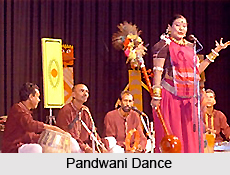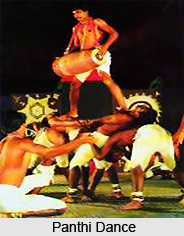Arts of Durg District portray the cultural climate of the place. Culture of Durg District is mainly tribal in nature and so is the art of the region. Durg District is densely populated district of the Chhattisgarh state of India.
Chhattisgarh is rich in its cultural heritage which is unique and vibrant culture. There are over 35 big and small colourful tribes spread over the region. Their rhythmic Folk music, dances and dramas thrives to be a visual treat providing an insight into the culture of the State.
The most famous dance-drama of the State is Pandwani, which is a musical narration of the great Hindu epic Mahabharata. Raut Nacha (folk dance of cowherds), the Panthi and Soowa are some of the other famous dance styles of the region.
 Pandwani Dance
Pandwani Dance
Pandwani is a folk ballad form that has the predominant stamp of the place, or rather is native to the region. It depicts the story of the Pandavas of Mahabharata the leading characters in the epic which is narrated in a very lively form, almost constructing the scenes in the minds of the audience. Teejan Bai has led to the popularity of such. Traditionally a male preserve, it has seen the inclusion of women artist in recent times. Teejan Bai the artists in the Pandwani narration consist of a lead artist and some supporting singers and musicians. The lead artist narrates one episode after another from the epic in a very forceful manner. The Actor enacts the characters in the scenes to produce a more realistic effect. Occasionally, he also breaks out into a dance movement. During the performance he sings along the rhythm produced by the Ektara held in his hand. There are two styles of narration in Pandwani; Vedamati and Kapalika. In the Vedamati style the lead artist narrates in a simple manner by sitting on the floor throughout the performance. The Kaplik style is livelier, where the narrator actually enacts the scenes and characters.
 Panthi Dance
Panthi Dance
Panthi Dance is the folk dance of the Satnamis of Chhattisgarh bears religious overtones. Performed on Maghi Purnima - the birth anniversary of Guru Baba Ghasidas, the dance is evolving still to include a variety of steps and patterns. The dancers dance around a jaitkhamb set up for the occasion, to the songs eulogizing their spiritual head. The songs also reflect the Nirvana philosophy, conveying the spirit of renunciation of their Guru and the teachings of saint poets like Kabir, Guru Ramdas Ji, Dadu, etc. Dancers with bent torsos and swinging arms continue to dance till carried away by their devotion. As the rhythm quickens, they indulge in acrobatics and even form human pyramids. The accompanying instruments included Mridanga and Jhaanj.
Raut Nacha Dance
Raut Nacha, the folk dance of cowherds, is a traditional folk dance of Yadava /Yaduvanshis as symbol of worship to Lord Krishna at the time of `dev udhni Ekadashi` (awakening of Gods after brief rest) according to the Hindu calendar. This dance showcases the enactment of the legendary combat in which the king named Kansa was defeated by the Yadava clan who were undoubtedly being led by Lord Krishna.
This dance performed after Diwali is a week long affair that indulges in the celebration of the bygone legendary victory. As they sparkle in glittering costumes, the gallant routs congregate soon after Diwali to display their skill and valour. Armed with sticks and metal shields, and bells tied to their waists which ring in mellifluous flow, the participants recreate the associated symbolic image of the ancient warriors. Earlier the festival was exquisitely confined to the clan of milk men also known as Rauts or Yadavs. But with time the scenario changed and the festival is celebrated with equal fervour throughout the nooks and corners of the district. As they swim resplendently in the clandestine memories of the warriors - the Rauts dance to the folk tunes and engage in mock duels. According to a legend, a king names Khasa was defeated by the yadavs, who were led by Lord Krishna. The Yadavs community thereafter celebrated their victory. A song and a dance festival - this Raut Nacha - was organised to celebrate the victory.



















